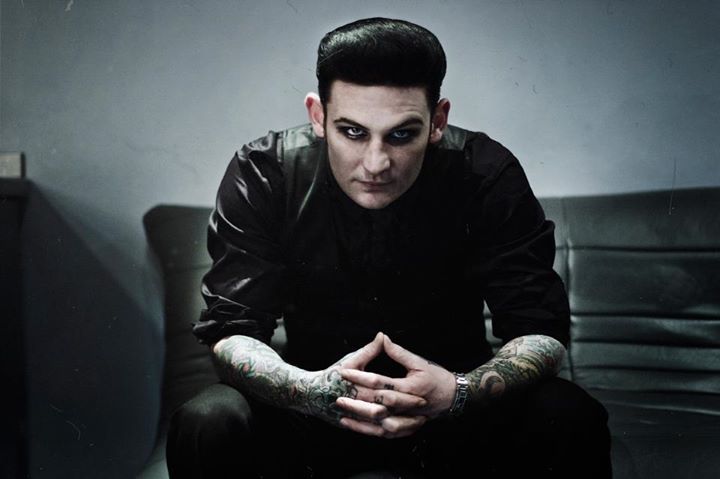True misanthropy isn’t directed against others – it would negate the thought itself.
Misanthropy is perhaps best utilized by observing others, and then directing it back inside. This introspective misanthropy inevitably ends in the obligatory discussion of what, then, can be done about this horrible, horrible person that I am? And unfortunately, the only solution to this problem is the final solution – self-destruction, absolute. If you are wondering what this has to do with this article, well, you are about to meet William Control.
Vorspiel
WiL Francis is most widely known for his vocal work in the alternative rock band, Aiden. Five years after Aiden was formed, in 2008,wiL Francis came up with a solo side-project, titled William Control. The debut, “Hate Culture” was a success, and was followed by the sophomore release, “Noir,” in 2010. Then came the EP, “Novus Ordo Seclorum” in 2011, which was followed by the third full-length, “Silentium Amoris” in 2012. Before ever proceeding into the music, the project itself has one aspect that needs to be observed, namely, the character or persona of William Control.
William Control is an introspective misanthrope that is fed up with the sheer amount of hate he sees around him. He is driven by a desire to discover, re-discover, define and re-define love, while also following his baser urges, especially those pertaining to (often BDSM-themed) his rampant sex drive. His first demand of his audience is that they do not like him – he is not to be liked at all. His story, as told in the first album, “Hate Culture,” is his introspective misanthropy expressed: William Control has decided that he has no more desire to exist in this world and its hate culture, so he will simply have one last night out, and then proceed to kill himself. Of course, he, for whatever reason, fails to do so, and wakes up on a London City Street after a night of drugging and partying, and he seeks his home, yet does not know where “home” is. Throughout “Noir,” he gradually finds himself by losing himself in the same thing he sought to kill himself to escape, and without emotion (“more than what I felt before,”) gives into the world, and chooses to continue existing in it. The story itself grows a bit more vague, dealing more with William Control’s mindset and condition rather than where he takes himself.
As a character, William Control is as poignant as he is often crude and direct. Lyrically, hard-hitting lines (“All this suffering – goddamn, don’t you care?”) mixing with the almost comical, (“Fuck, fuck, fuck, I wanna fuck till we bleed”) and the forlorn (“You are a beautiful Noir, a cinematic film that only I see.”) It is not for wanting of a better voice, but for a better thing to write about that William Control comes off as cynical, sexually-charged, bitter and morbid, although at times a bit sure of himself (“Why Dance With the Devil When You Have Me?”) Just the song title of “Come Die With Me” is enough – yet, there are times of hope. “I’m Only Human Sometimes” and “The Optimist Within Me” are two examples of a brighter today in the world of William Control.
Ultrasound
The music itself is difficult to pin down, comprising of several trace elements of different genres. Most of the time, the songs follow the classical verse-chorus-verse-chorus-bridge-chorus structure, although there are notable exceptions (“Razor’s Edge” and “I’m Only Human Sometimes” being two examples.) While vocals are used on their own, sometimes, spoken word passages are also utilized; and wiL Francis does his own back vocals. Another staple of the William Control sound in this department is the “background moans;” ranging from sensual to erotic to blatantly sexual, some songs feature a background noise of women moaning (in the instance of “The Whipping Haus,” also whips cracking.)
In terms of instrumentalization, William Control blends genres of rock, synthpop, industrial and darkwave – but the music lends itself to other genres, at one point, for instance, hip-hop and ballads and/or ballad-soft songs are not uncommon. One trademark of the William Control sound is the beats: more than a few songs feature simplistic, yet complex drum machines that come together to create a vast, continuous beat while retaining a degree of depth. A better description might be that often drums resemble skipping pebbles on a pond – the overall beat is the water, rippling and the more prominent, bounding bass kicks are the pebbles. Another trademark is the thin, wailing synthesizer sound somewhat resembling a siren, used for main melodies. This is married to thicker, moog-like sequencers for the bass, which make their first appearance in the first song ever of William Control, and believe me, are here to stay.
William Control will continue, Francis has promised. He has announced that he his working on the new album, this time a prequel to “Hate Culture,” dealing with the character’s origins. Whether that one will disprove this article or not remains to be seen.
Discography
2008 – Hate Culture
2010 – Noir
2011 – Novus Ordo Seclorum
2012 – Silentium Amoris
2013 – Skeleton Strings (announced)




